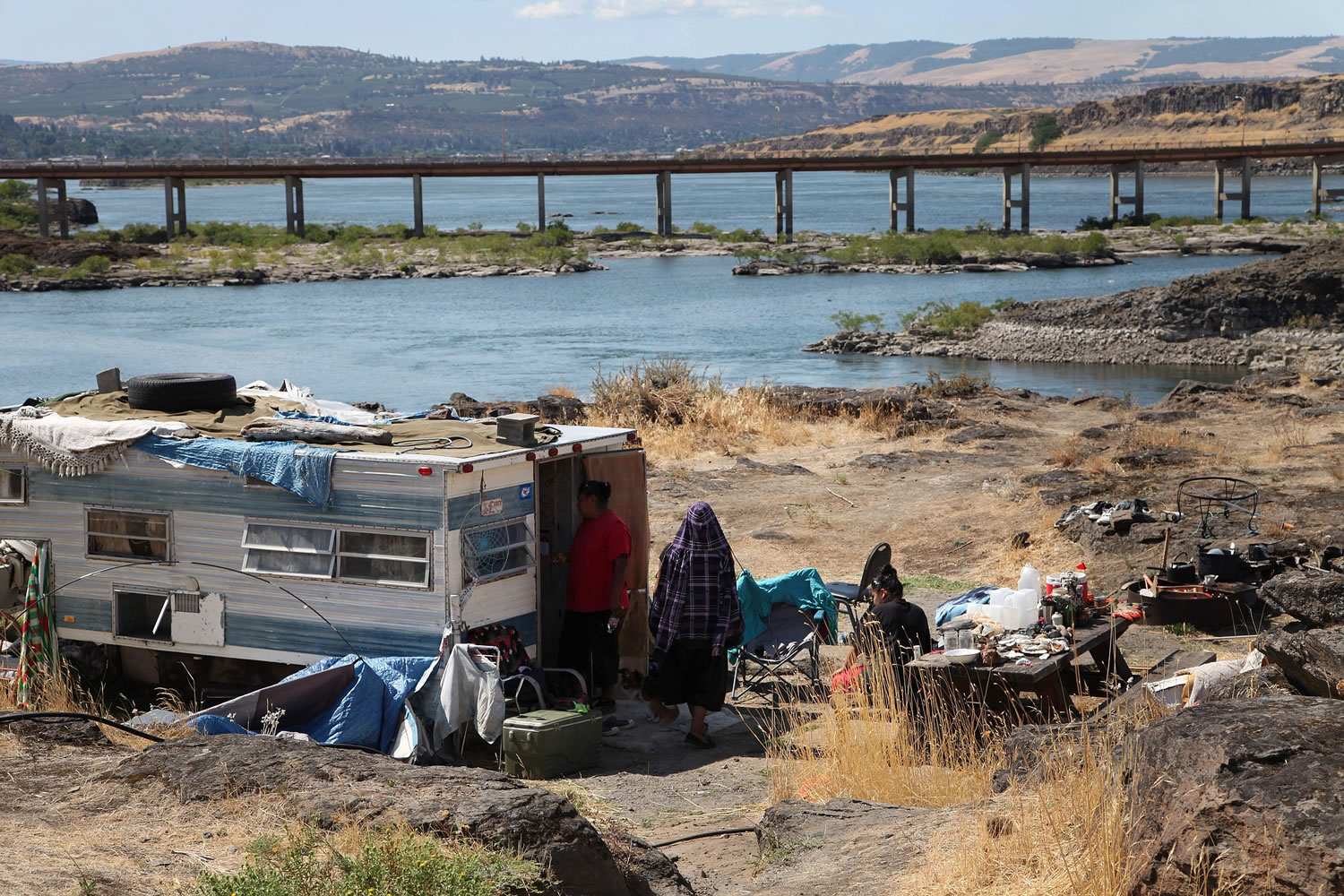LONE PINE, Ore. — Bernadette Grace’s trailer is hidden behind a larger trailer charred and strewn with trash. It’s far enough from the communal restroom and shower without doors, where drunks linger after dark. But close enough to the icy waters that sustain her.
Home is a scrap of rock and dried grass that juts out into the Columbia River, with a view of the massive Dalles Dam. The river is a constant reminder of Grace’s Native American heritage; the dam is the root cause of all that her people lost when the backwaters swallowed houses, fishing platforms and burial grounds.
“The river, it’s my calm spot. Since I was a baby, I’ve been on a boat with my mom and dad,” Grace says.
From the drying shed where Grace hangs salmon to smoke, makeshift structures spread like a shantytown: shacks, trailers with broken windows, old tires, couches and rusted boats.
Lone Pine is an 8-acre fishing site provided by the federal government to compensate tribes for the loss of fishing grounds inundated by the dam in 1957. It’s one of 31 replacement fishing sites, scattered among four dams on the Oregon and Washington shores.
The sites are for fishermen from four tribes: the Nez Perce, Umatilla, Warm Springs, and Yakama. But they also serve as substandard permanent residences for Indians like Grace whose relatives were displaced by the dams.
“It’s shocking, the living conditions on those sites,” said David Sauter, board member of the Columbia Gorge Housing Authority, who toured the settlements this summer. “It’s like a Third World, terrible sanitary conditions, whole communities functioning with a single water spigot.”
Native American leaders are now pressing the U.S. government to provide housing to the river Indians — something they argue is owed to them because Indians received meager compensation for dam-caused destruction.
The tribes point to a federal fact-finding report which shows there are Native families who were dislocated by the dams who did not receive relocation assistance or alternative housing.
The report was issued earlier this year. So far, it has been greeted with silence.
For millennia, Native Americans lived in villages along the Columbia’s shores, the river and its salmon central to their culture and religion, sustenance and trade.
To save their fishing-centered way of life after the arrival of European settlers, the tribes in 1855 signed treaties with the U.S. government in which they reserved the right to fish at their “usual and accustomed” sites.
Dam construction upended that way of life.
Between the 1930s and the 1970s, the U.S. government built four dams — the Bonneville, the Dalles, the John Day and the McNary — on the Columbia east of Portland. Dozens of communities and homes were destroyed.
Federal officials relocated and in some cases entirely reconstructed several non-Indian towns, compensating their residents. Native villagers were not treated the same way, according to tribal and government documents.
The report commissioned by the U.S. Army Corps of Engineers found at least three village sites were torn down due to Bonneville Dam construction. None of the 40-plus families were compensated.
And at least two villages were destroyed by the Dalles Dam. The government handed out some relocation assistance and placed 10 barracks near Celilo village. But the money and homes helped only a fraction of the Indians.
The federal government developed replacement fishing sites to compensate for those flooded by the dams. Tribal leaders say the government also promised to rebuild living quarters, but later denied making the promise.
The Indians who set up permanent homes in drying sheds and other structures at the sites faced years of harassment from officials and non-Indian fishermen, who didn’t want Indians fishing or living on the river.
In the 1980s, a judge found Indians had maintained homes at their fishing sites prior to dam construction and could do so again.
The Corps admits the government’s policy of assimilation influenced how it handled Indian housing.
But the Corps’ Portland office would need a go-ahead from its Washington headquarters to do an exhaustive study of dams’ impact on tribal housing, said project manager Eric Stricklin. And Congress would have to OK construction and funding.
Lone Pine’s roughly 40 residents have added makeshift plumbing or additions to sheds and trailers. None of the housing is built to code, tribal leaders say.
Three years ago, the Columbia River Inter-Tribal Fish Commission — a Portland-based organization run by the tribes — took over management of the sites, though the Bureau of Indian Affairs still has administrative jurisdiction.
The fish commission embarked on a three-year cleanup campaign, pulling out garbage and renovating restrooms. But as soon as cleanup was completed, people moved back onto the sites to live.
“But the problem remains. … There is a housing crisis out there,” the commission’s director Paul Lumley said.
Finding affordable housing near the river isn’t an option. Rents along the Columbia skyrocketed when the towns became destinations for windsurfers and other tourists.
And record salmon returns in recent years have drawn even more Indians to fish. Because fishermen want to be near their nets, more are camping at the sites, worsening the housing problem.
Tribal leaders say solutions to the housing crisis could vary, from rebuilding or adding infrastructure at the sites where possible, to finding or building alternative housing — as long as it’s near the river.



